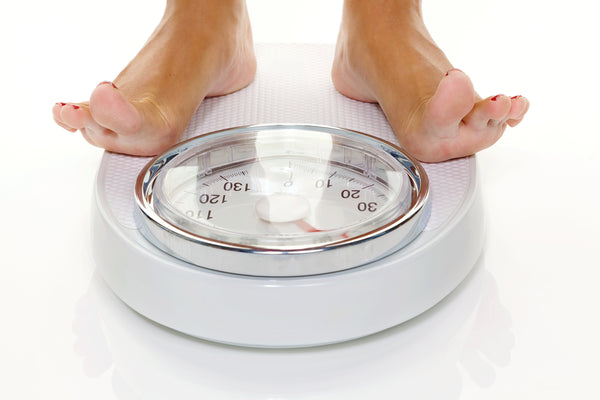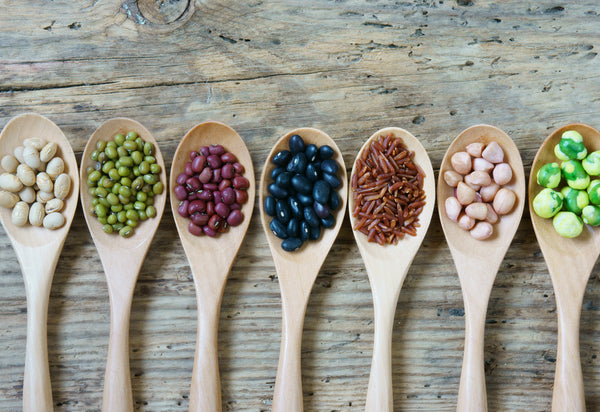With the rapid rise in popularity of diabetes drugs such as Ozempic and Wegovy that are now being used to aid in weight loss, it can be helpful to take a closer look at exactly what Glucagon-like peptide (GLP-1) is, how GLP-1 stimulators work, and also where you might find this effect naturally- such as by drinking matcha! While prescription medication, such as this new class of diabetes and weight loss medication, absolutely serves a purpose and can quite literally be life-saving, many individuals are wondering if it’s possible to get this same support from more natural sources. And as it turns out, the answer is yes!
These new medications contain a compound known as semaglutide that can help squash hunger. People who use these medications often report that they get a break from constantly feeling hungry and craving certain foods. People, therefore, eat less frequently and in smaller quantities. These drugs work by mimicking a hormone our body naturally produces when eating called GLP-1. Studies show that by making changes to our diet, we can increase this hormone naturally.
Why weight loss is hard
If you’ve ever tried losing weight, then you know it can be HARD. And no, this isn’t because you lack “willpower”. Your body actually works against you when you try to lose weight. Our weight is tightly controlled by complex interactions of hormones and neurons- your brain controls how hungry and thirsty you are and also influences your appetite and how much food you eat.
All this to say that while we are technically in control over our appetite and what we eat, our brains can make changes to our diet especially hard. There are a few different reasons for this.
As we start losing weight, our bodies adapt by lowering our metabolic resting rate. That’s how much energy our bodies require to function at rest. And energy comes from calories! So, as we start losing weight, we require fewer calories, meaning we have to eat less and less. The reason for this is that if weight loss is occurring due to starvation and food is scarce our bodies start to conserve and adapt to needing less as a protection method.
Another reason weight loss can be so difficult is the hormone leptin. Leptin is a hormone that manages energy and sends signals to your brain that you’re satiated. However, when leptin resistance occurs, which can be common in overweight people, the brain is no longer receptive to that sensation.
Leptin is found in fat cells and is key for appetite regulation. Leptin levels increase with body fat, so people with obesity tend to have much higher levels of leptin. These high levels of leptin should signal to your brain that there’s enough energy stored and that you’re satiated, however, with leptin resistance, your brain continues to think you’re starving. This can drive up hunger and can cause you also to reduce activity in order to conserve energy. When trying to lose weight, leptin resistance can also increase your hunger and appetite, reduce your motivation to move, and decrease your metabolism. Making it extremely difficult to lose those extra pounds.
GLP-1
Drugs like Wegovy and Ozempic are known as GLP-1 agonists and are designed to manage healthy blood sugar levels. They also happen to reduce hunger and, therefore, overall food intake. GLP-1 agonists mimic a naturally produced hormone known as glucagon-like peptide 1 (GLP-1). GLP-1 is involved in many processes, including stimulation of insulin (which regulates blood sugar levels), suppresses glucagon (a hormone which can reduce hunger), and delays stomach emptying, which can increase feelings of satiation.
GLP-1 agonists bind to GLP-1 receptors and, therefore, work the same as GLP-1. While GLP-1 agonists were initially intended for the treatment of type II diabetes, they are now regularly being used and prescribed to aid in weight loss. But what about naturally occurring GLP-1?
GLP-1 is naturally produced and released when food enters the stomach. It signals the pancreas to release insulin, reduces inflammation, and increases the feeling of satiety. Some of the ways you can increase GLP-1 naturally are by eating foods rich in fiber, incorporating healthy fats, staying hydrated, prioritizing sleep, managing stress and drinking green tea.
How green tea can help with weight loss 
While more studies are needed, recent research shows that green tea extract may significantly improve insulin resistance and can increase glucagon-like peptide-1. Studies also show that drinking matcha green tea may increase metabolism and fat burning, both of which can make losing weight a bit easier.
Matcha has higher amounts of EGCG compared to loose-leaf green tea. EGCG has been shown in studies to boost metabolism and increase thermogenic effects in the body (the rate at which your body burns calories). EGCG has been shown in multiple studies to have a beneficial effect against obesity and may naturally increase GLP-1 levels.
Learn more about matcha and weight loss.
How to increase GLP-1 naturally through diet
Increase fiber
Fibrous foods are key for triggering GLP-1. However, researchers at the University of Arizona have discovered that not all fiber is the same when it comes to releasing GLP-1. Foods such as oats, barley, rye, beans, and lentils may be best when it comes to GLP-1 production. Try not to get too much in your head about it, though. By being more conscious of your overall fiber consumption, you’ll improve your digestion and may improve weight loss outcomes.
Drink matcha
Matcha has been shown to decrease insulin resistance, reduce inflammation and may be useful for increasing GLP-1 production. Matcha is rich in antioxidants and contains L-theanine, the powerful amino acid known to help you feel calm and relaxed.
Learn more about the health benefits of matcha
Stay hydrated
Staying hydrated is key for overall health, and research shows hydration is also important for healthy GLP-1 levels. While water recommendations can change from person to person, a good goal is to aim for at least 64 oz of water each day.
Exercise
Exercise may be able to positively influence GLP-1 levels. Regular exercise can also help with healthy blood sugar levels and improve insulin sensitivity. A combination of cardio and strength workouts seems to maximize GLP-1 release.
Prioritize protein
Protein has been linked to GLP-1 secretion and is also helpful in weight management, muscle growth, and increasing satiety.
Eat healthy fats
Healthy fats such as avocados, olive oil, nuts, and seeds have been shown to increase GLP-1 levels in people with type II diabetes. Incorporating fats into your diet can also help you feel full and satisfied for longer.
Manage stress
Chronic stress may lead to insulin resistance and can also influence our eating behaviors and increase food cravings. High levels of cortisol have also been shown to reduce GLP-1 levels. Stress management techniques such as breathing, meditation, yoga, and spending time with people you love can all help to increase GLP-1 production and support a healthy weight.
Find out more about the anti-inflammatory diet and how it can help with weight loss

Bottom Line:
While medications such as Wegovy and Ozempic have been helpful for some individuals, there are natural ways to increase GLP-1 production and, alongside diet and exercise, aid in weight loss. Eating a healthy diet rich in fibrous foods, healthy fats, and protein can all help increase GLP-1 secretion. Matcha green tea has also been shown to be useful in improving insulin sensitivity, increasing metabolism, and releasing GLP-1.
Disclaimer: These statements in this blog post have not been evaluated by the Food and Drug Administration. The information provided here is for educational purposes only and should not be considered medical advice. It's essential to consult with a qualified healthcare professional before making any dietary or lifestyle changes.
References:
Dornbush S, Aeddula NR. Physiology, Leptin. [Updated 2023 Apr 10]. In: StatPearls [Internet]. Treasure Island (FL): StatPearls Publishing; 2024 Jan-. Available from: https://www.ncbi.nlm.nih.gov/books/NBK537038/
Hira T, Trakooncharoenvit A, Taguchi H, Hara H. Improvement of Glucose Tolerance by Food Factors Having Glucagon-Like Peptide-1 Releasing Activity. Int J Mol Sci. 2021 Jun 21;22(12):6623. doi: 10.3390/ijms22126623. PMID: 34205659; PMCID: PMC8235588.
Holst JJ. The physiology of glucagon-like peptide 1. Physiol Rev. 2007 Oct;87(4):1409-39. doi: 10.1152/physrev.00034.2006. PMID: 17928588.
Liu CY, Huang CJ, Huang LH, Chen IJ, Chiu JP, Hsu CH. Effects of green tea extract on insulin resistance and glucagon-like peptide 1 in patients with type 2 diabetes and lipid abnormalities: a randomized, double-blinded, and placebo-controlled trial. PLoS One. 2014 Mar 10;9(3):e91163. doi: 10.1371/journal.pone.0091163. PMID: 24614112; PMCID: PMC3948786.
Liu J, Yang X, Yu S, Zheng R. The Leptin Resistance. Adv Exp Med Biol. 2018;1090:145-163. doi: 10.1007/978-981-13-1286-1_8. PMID: 30390289.
Müller TD, Finan B, Bloom SR, D'Alessio D, Drucker DJ, Flatt PR, Fritsche A, Gribble F, Grill HJ, Habener JF, Holst JJ, Langhans W, Meier JJ, Nauck MA, Perez-Tilve D, Pocai A, Reimann F, Sandoval DA, Schwartz TW, Seeley RJ, Stemmer K, Tang-Christensen M, Woods SC, DiMarchi RD, Tschöp MH. Glucagon-like peptide 1 (GLP-1). Mol Metab. 2019 Dec;30:72-130. doi: 10.1016/j.molmet.2019.09.010. Epub 2019 Sep 30. PMID: 31767182; PMCID: PMC6812410.
Poraj-Weder M, Wąsowicz G, Pasternak A. Why it is so hard to lose weight? An exploration of patients' and dietitians' perspectives by means of thematic analysis. Health Psychol Open. 2021 Jun 18;8(1):20551029211024406. doi: 10.1177/20551029211024406. PMID: 34211722; PMCID: PMC8216368.
Obradovic M, Sudar-Milovanovic E, Soskic S, Essack M, Arya S, Stewart AJ, Gojobori T, Isenovic ER. Leptin and Obesity: Role and Clinical Implication. Front Endocrinol (Lausanne). 2021 May 18;12:585887. doi: 10.3389/fendo.2021.585887. PMID: 34084149; PMCID: PMC8167040.
Yaribeygi H, Jamialahmadi T, Moallem SA, Sahebkar A. Boosting GLP-1 by Natural Products. Adv Exp Med Biol. 2021;1328:513-522. doi: 10.1007/978-3-030-73234-9_36. PMID: 34981502.







